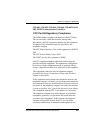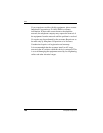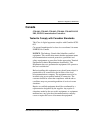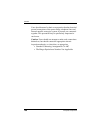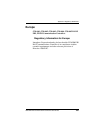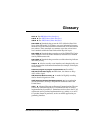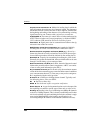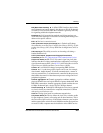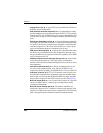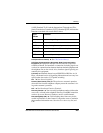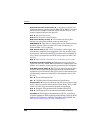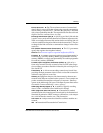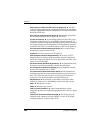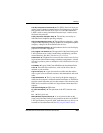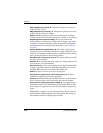
Glossary
5536 PRI RAS Communications Controller Users Guide 203
BRI (Basic Rate Interface) A defined ISDN interface that includes
two B channels and one D channel. Also known as 2B+D. B channels
are used for voice and data while the D channel is generally used only
for signalling within the telephone network.
Broadcast LAN transmission method used in bus topology net-
works that sends messages to all stations even though the messages are
addressed to specific stations.
BTU See basic transmission unit.
CALC (Customer Access Line Charge) A Federal tariff charge,
also referred to as an End User Common Line Charge (EUCL), or Sub-
scriber Line Charge (SLC). Every ISDN line is charged one CALC or
EUCL.
Call bumping The ability to receive an incoming call during a
bonded outbound call.
CCITT (International Telephone and Telegraph Consultative
Committee)
See ITU (International Telecommunication Union).
CD (Carrier Detect) RS-232 (V.24) control signal (on pin 8) that
indicates that the local data communications equipment is receiving a
signal from the remote DCE. (See RS-232.) Also called Received Line
Signal Detector (RLSD) and Data Carrier Detect (DCD).
Centrex Local Public Exchange incorporating PBX facilities.
Channel 1) A path along which signals can be sent, for example
data channel, output channel. 2) In data communication, a means of
one-way transmission. 3) A function unit, controlled by the processor,
that handles the transfer of data between processor storage and local
peripheral equipment.
Channel aggregation Channel aggregation combines multiple
physical channels into one logical channel of greater bandwidth. With
BRI ISDN connections, channel aggregation would combine the two
64 Kbps B channels into a single, logical 128 Kbps channel.
Circuit-switching Technique in which physical circuits (as opposed
to virtual circuits) are transferred to complete connections. Contrast
with packet-switched networks.
Clock Timing signal used in synchronous transmission.
CO (Central Office) The site where the local Telco switches reside
for the telephone system's call routing and all other functions. This is
the Telco side of the local loop. If the distance between your location
and the central office switch exceeds 18,000 feet and/or the signal loss
exceeds 35.0 dB, a repeater must be installed to allow ISDN service.



